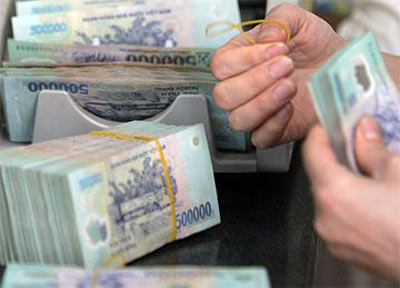
Banks are given higher credit growth targets
The adjustment followed State Bank Governor Nguyen Van Binh's announcement on Thursday that credit institutions would be urged to help boost the nation's economic growth in the second half of the year.
Of the nation's 62 credit institutions, 23 wanted to increase their credit growth quotas. The State Bank has agreed to increase the quotas for 10 banks with lending totals in the first half of the year outpacing quotas.
Earlier this year, the State Bank divided banks into four groups depending upon their performance in the prior year. Banks were allocated credit growth quotas according to their group designations. Group 1 (healthy banks) were given a target of 17 percent, while Group 2 (average banks) received a target of 15 percent, Group 3 (below-average banks) a target of 8 percent. Group 4 (weak banks) were not allocated a credit growth quota.
Average credit growth higher than 15-per-cent was deemed inflationary.
In the first half of this year, however, credit in the commercial banking sector grew by an average of just 1.51 percent over the previous year, with 69 credit institutions seeing credit decline while 57 others saw growth.
To ease enterprises' access to credit, interest rates have also been lowered. The proportion of outstanding loans in Vietnamese dong with interest rates in excess of 15 percent per year has fallen to about 29 percent of total lending, a decrease of 60 percent since the State Bank asked commercial banks a few weeks ago to refinance outstanding loans at rates below 15 percent.
The lower interest rate of 15 percent was aimed at getting banks to share difficulties with enterprises, reducing their profit margins to ensure economic stability. A number of enterprises have remained reluctant, however, to take out additional loans.
"Low interest rates are no longer a vital factor in attracting enterprises," Eximbank general director Truong Van Phuoc told the newspaper Nguoi Lao Dong (The Labourer) yesterday. "Low purchasing power has made them cautious."
According to an Eximbank analysis, Phuoc said, interest costs currently accounted for 24 percent of business expenditures.
The sharp decrease in lending rates has not spurred businesses to increase borrowing because purchasing power in the market remained depressed, economists agreed. As of the end of July, outstanding loans at commercial banks had risen only 0.57 percent over the end of last year despite lending interest rates falling from an average of 17-18 percent to 10-15 percent.
Many economists have called for new policies to stimulate consumer demand, criticising policymakers for focusing too much on fighting inflation, leading to rapid increase in unsold inventories and an economic slowdown.
With deposit interest rates now average 9 percent per year and lending rates held below 15 percent, some have argued that banks have favourable conditions to reduce lendings rates further, to 11-12 percent.
However, financial specialist Nguyen Dac Hung noted that banks have to allocate 3 percent of profits for compulsory reserves and maintain a 10-percent payment reserve, as well as cover operating costs.
Rising bad debts have also cut into bank profit margins. Some experts have suggested the Government allow commercial banks to write off bad debts against capital reserves.

Leave your comment on this story